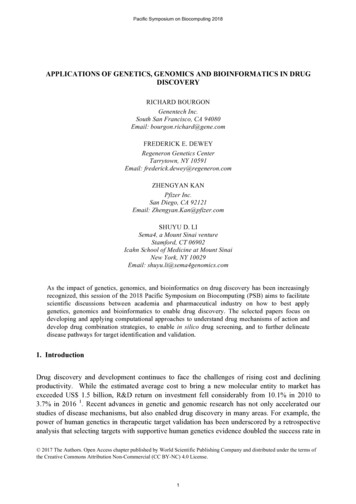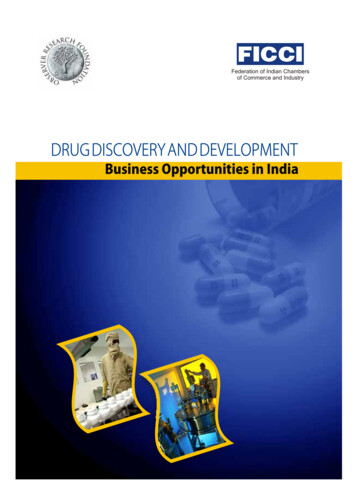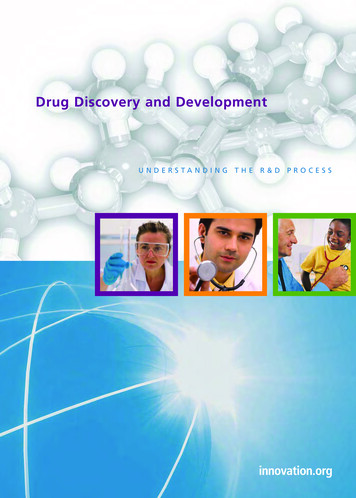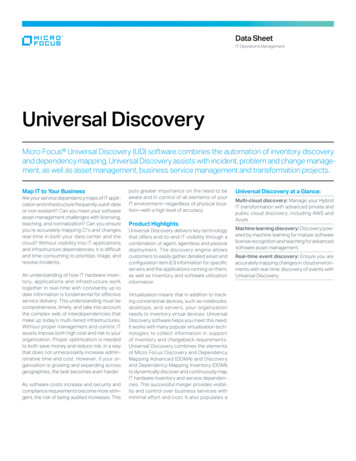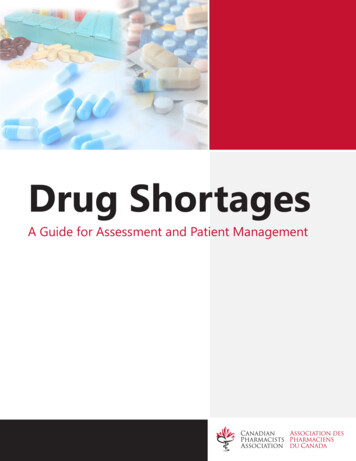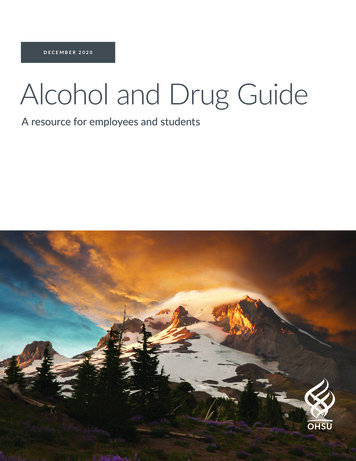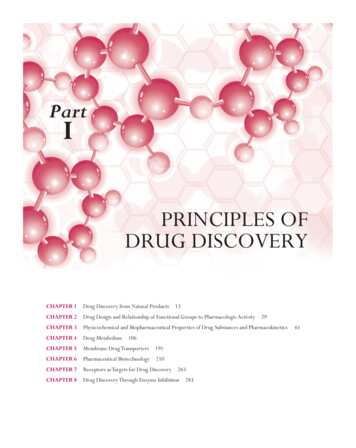
Transcription
PartIPRINCIPLES OFDRUG DISCOVERYCHAPTER 1Drug Discovery from Natural Products 13CHAPTER 2Drug Design and Relationship of Functional Groups to Pharmacologic Activity 29CHAPTER 3Physicochemical and Biopharmaceutical Properties of Drug Substances and PharmacokineticsCHAPTER 4Drug Metabolism 106CHAPTER 5Membrane Drug Transporters 191CHAPTER 6Pharmaceutical Biotechnology 210CHAPTER 7Receptors as Targets for Drug Discovery 263CHAPTER 8Drug Discovery Through Enzyme Inhibition 283Lemke Chap01.indd 116112/9/2011 1:35:39 AM
Chapter1Drug Discovery fromNatural ProductsA. D O U G L A S K I N G H O R NAbbreviationsCAM, complementary and alternativemedicineCNS, central nervous systemCOPD, chronic obstructive pulmonarydiseaseDSHEA, Dietary Supplement Health andEducation ActGLP-1, glucagon-likepeptide-1HMG-CoA, 5-hydroxy-3-methylglutaryl–coenzyme AHPLC, high-performance liquidchromatographyHTS, high-throughput screeningLC, liquid chromatographyM6G, morphine-6-glucuronideMOA, memorandum of agreementMS, mass spectrometryINTRODUCTION“Pharmacognosy” is one of the oldest established pharmaceutical sciences, and the term has been used fornearly two centuries. Initially, this term referred to theinvestigation of medicinal substances of plant, animal, ormineral origin in their crude or unprepared state, usedin the form of teas, tinctures, poultices, and other typesof formulation (1–4). However, by the middle of the20th century, the chemical components of such crudedrugs began to be studied in more detail. Today, the subject of pharmacognosy is highly interdisciplinary, andincorporates aspects of analytical chemistry, biochemistry, biosynthesis, biotechnology, ecology, ethnobotany,microbiology, molecular biology, organic chemistry, andtaxonomy, among others (5). The term “pharmacognosy” is defined on the Web site of the American Societyof Pharmacognosy (www.phcog.org) as “the study of theNCE, new chemical entityNMR, nuclear magnetic resonancePVP, polyvinylpyrrolidoneSCE, single chemical entitySPE, solid-phase extractionTHC, tetrahydrocannabinolUNCLOS, United Nations Conventionon the Law of the Seaphysical, chemical, biochemical, and biological properties of drugs, drug substances, or potential drugs or drugsubstances of natural origin, as well as the search for newdrugs from natural sources.”There seems little doubt that humans have used natural drugs since before the advent of written history. Inaddition to their use as drugs, the constituents of plantshave afforded poisons for darts and arrows used in hunting and euphoriants with psychoactive properties used inrituals. The actual documentation of drugs derived fromnatural products in the Western world appears to date asfar back to the Sumerians and Akkadians in the third century bce, as well as the Egyptian Ebers Papyrus (about 1600bce). Other important contributions on the uses of drugsof natural origin were documented by Dioscorides (DeMateria Medica) and Pliny the Elder in the first centuryce and by Galen in the second century. Written recordsalso exist from about the same time period on plants13Lemke Chap01.indd 1312/9/2011 1:35:40 AM
14PART I / PRINCIPLES OF DRUG DISCOVERYused in both Chinese traditional medicine and Ayurvedicmedicine. Then, beginning about 500 years ago, information on medicinal plants began to be documented inherbals. In turn, the laboratory study of natural productdrugs commenced approximately 200 years ago, with thepurification of morphine from opium. This correspondswith the beginnings of organic chemistry as a scientificdiscipline. Additional drugs isolated from plant sourcesincluded atropine, caffeine, cocaine, nicotine, quinine,and strychnine in the 19th century, and then digoxin,reserpine, paclitaxel, vincristine, and chemical precursors of the steroid hormones in the 20th century. Even aswe enter the second decade of the 21st century, approximately three quarters of the world’s population are reliant on primary health care from systems of traditionalmedicine, including the use of herbs. A more profoundunderstanding of the chemical and biologic aspects ofplants used in the traditional medicine of countries suchas the People’s Republic of China, India, Indonesia, andJapan has occurred in recent years, in addition to themedicinal plants used in Latin America and Africa. Manyimportant scientific observations germane to naturalproduct drug discovery have been made as a result (1–4).By the mid-20th century, therapeutically useful alkaloids had been purified and derivatized from the ergotfungus, as uterotonic and sympatholytic agents. Then,the penicillins were isolated along with further majorstructural classes of effective and potent antibacterialsfrom terrestrial microbes, and these and later antibiotics revolutionized the treatment of infectious diseases.Of the types of organisms producing natural products,terrestrial microorganisms have been found to afford thelargest number of compounds currently used as drugsfor a wide range of human diseases, and these includeantifungal agents, the “statin” cholesterol-loweringagents, immunosuppressive agents, and several anticancer agents (6,7).At present, there remains much interest also in the discovery and development of drugs from marine animalsand plants. However, to date, marine organisms have hada relatively brief history in serving as sources of drugs,with only a few examples approved for therapeutic usethus far. Although the oceans occupy 70% of the surfaceof the earth, an intense effort to investigate the chemicalstructures and biologic activities of the marine fauna andflora has only been ongoing for about 40 years (8).The term “natural product” is generally taken tomean a compound that has no known primary biochemical role in the producing organism. Such low molecular weight organic molecules may also be referred to as“secondary metabolites” and tend to be biosynthesizedby the producing organism in a biologically active chiralform to increase the chances of survival, such as by repelling predators or serving as insect pollination attractants,in the case of plants (9). There have been a number ofstudies to investigate the physicochemical parameters ofnatural products in recent years, and it has been concluded that “libraries” or collections of these substancesLemke Chap01.indd 14tend to afford a higher degree of “drug-likeness,” whencompared with compounds in either synthetic or combinatorial “libraries” (10,11). This characteristic mightwell be expected, since natural products are producedby living systems, where they are subject to transportand diffusion at the cellular level. Small-molecule natural products are capable of modulating protein–proteininteractions and can thus affect cellular processes thatmay be modified in disease states. When compared to synthetic compounds, natural products tend to have moreprotonated amine and free hydroxy functionalities andmore single bonds, with a greater number of fused ringscontaining more chiral centers. Natural products alsodiffer from synthetic products in the average number ofhalogen, nitrogen, oxygen, and sulfur atoms, in additionto their steric complexity (12,13). It is considered thatnatural products and synthetic compounds occupy different regions of “chemical space,” and hence, they eachtend to contribute to overall chemical diversity requiredin a drug discovery program (13). Fewer than 20% of thering systems produced among natural products are represented in currently used drugs (10). Naturally occurring substances may serve either as drugs in their nativeor unmodified form or as “lead” compounds (prototypebioactive molecules) for subsequent semisynthetic ortotally synthetic modification, for example, to improvebiologic efficacy or to enhance solubility (1–4,6,8,10,11).In the present era of efficient drug design by chemical synthesis aided by computational and combinatorial techniques, and with other new drugs obtainedincreasingly by biotechnologic processes, it might beexpected that traditional natural products no longerhave a significant role to play in this regard. Indeed, inthe past two decades, there has been a decreased emphasis on the screening of natural products for new drugsby pharmaceutical companies, with greater relianceplaced on screening large libraries of synthetic compounds (10,11,14,15). However, in a major review article, Newman and Cragg from the U.S. National CancerInstitute pointed out that for the period from 1981 to2006, about 28% of the new chemical entities (NCEs) inWestern medicine were either natural products per seor semisynthetic derivatives of natural products. Thus,of a total of 1,184 NCEs for all disease conditions introduced into therapy in North America, Western Europe,and Japan over the 25.5-year period covered, 5% wereunmodified natural products and 23% were semisynthetic agents based on natural product lead compounds.An additional 14% of the synthetic compounds weredesigned based on knowledge of a natural product“pharmacophore” (the region of the molecule containing the essential organic functional groups that directlyinteract with the receptor active site and, therefore, confers the biologic activity of interest) (16). The launchof new natural product drugs in Western countries andJapan has continued in the first decade of 21st century,and such compounds introduced to the market recentlyhave been documented (14,16–18).12/9/2011 1:35:41 AM
CHAPTER 1 / DRUG DISCOVERY FROM NATURAL PRODUCTSThus, it is generally recognized that the secondarymetabolites of organisms afford a source of small organicmolecules of outstanding chemical diversity that arehighly relevant to the contemporary drug discovery process. Potent and selective leads are obtained from moreexotic organisms than before, as collection efforts venture into increasingly inhospitable locales throughoutthe world, such as deep caves in terrestrial areas andthermal vents on the ocean floor. On occasion, a natural lead compound may help elucidate a new mechanismof interaction with a biologic target for a disease stateunder investigation. Natural products may serve to provide molecular inspiration in certain therapeutic areasfor which there are only a limited number of syntheticlead compounds. A valuable approach is the large-scalescreening of libraries of partially purified extracts fromorganisms (11). However, there is a widespread perception that the resupply of the source organism of a secondary metabolite of interest may prove problematic and willconsequently hinder the timely, more detailed, biologicevaluation of a compound available perhaps only in milligram quantities initially. In addition, natural productextracts have been regarded as incompatible with themodern rapid screening techniques used in the pharmaceutical industry, and some believe that the successfulmarket development of a natural product–derived drugis too time consuming (10,11,14,15). A further consideration of the factors involved in the discovery of drugsfrom natural products will be presented in the next section of this chapter. This will be followed by examplesof natural products currently used in various therapeuticcategories, as well as a few selected representatives withpresent clinical use or future potential in this regard.NATURAL PRODUCTS AND DRUG DISCOVERYCollection of Source OrganismsThere are at least five recognized approaches to thechoice of plants and other organisms for the laboratoryinvestigation of their biologic components, namely, random screening; selection of specific taxonomic groups,such as families or genera; a chemotaxonomic approachwhere restricted classes of secondary metabolites such asalkaloids are sought; an information-managed approach,involving the target collection of species selected bydatabase surveillance; and selection by an ethnomedicalapproach (e.g., by investigating remedies being used intraditional medicine by “shamans” or medicine men orwomen) (19). In fact, if plant-derived natural productsare taken specifically, it has been estimated that of 122drugs of this type used worldwide from a total of 94 species, 72% can be traced to the original ethnobotanicaluses that have been documented for their plant of origin(19). The need for increased natural products discoveryresearch involving ethnobotany should be regarded asurgent, due to the accelerating loss in developing countries of indigenous cultures and languages, inclusive ofLemke Chap01.indd 1515knowledge of traditional medical practice (20). However,it is common for a given medicinal plant to be used ethnomedically in more than one disease context, whichmay sometimes obscure its therapeutic utility for a specific disease condition. Another manner in which drugshave been developed from terrestrial plants and fungi isthrough following up on observations of the causes oflivestock poisoning, leading to new drugs and molecular tools for biomedical investigation (21). When theorigin of plants with demonstrated inhibitory effects inexperimental tumor systems was considered at the U.S.National Cancer Institute, medicinal or poisonous plantswith uses as either anthelmintics or arrow and homicidalpoisons were three to four times more likely to be activein this regard than species screened at random (22).Although some shallow water marine specimens maybe collected simply by wading or snorkeling down to20 feet below the water surface, scuba diving permitsthe collection of organisms to depths of 120 feet. Deepwater collections of marine animals and plants have beenmade by dredging and trawling and through the use ofmanned and unmanned submersible vessels. Collectionstrategies for specimens from the ocean must take intoaccount marine macroorganism–microorganism associations that may be involved in the biosynthesis of a particular secondary metabolite of interest (8). Thus, thereseems to be a complex interplay between many marinehost invertebrate animals and symbiotic microbes thatinhabit them, and it has been realized that several bioactive compounds previously thought to be of animal origin may be produced by their associated microorganismsinstead (23).The process of collecting or surveying a large set offlora (or fauna) for the purpose of the biologic evaluation and isolation of lead compounds is called “biodiversity prospecting” (24). Many natural products collectionprograms are focused on tropical rain forests, in orderto take advantage of the inherent biologic diversity (or“biodiversity”) evident there, with the hope of harnessingas broad a profile of chemical classes as possible amongthe secondary metabolites produced by the species to beobtained. To exemplify this, there may be more tree species in a relatively small area of a tropical rainforest thanin the whole of the temperate regions of North America.A generally accepted explanation for the high biodiversity of secondary metabolites in humid forests in the tropics is that these molecules are biosynthesized (a processof chemical synthesis by the host organism) for ecologicroles, in response to a continuous growing season underelevated temperatures, high humidity, and great competition due to the high species density present. Maximalbiodiversity in the marine environment is found on thefringes of the ocean or sea bordering land, where there isintense competition among sessile (nonmoving) organisms, such as algae, corals, sponges, and some otherinvertebrate animals, for attachment space (25).Great concern should be expressed about the continuing erosion of tropical rain forest species, which12/9/2011 1:35:41 AM
16PART I / PRINCIPLES OF DRUG DISCOVERYis accelerating as the 21st century develops (26).Approximately 25 “hot spots” of especially high biodiversity have been proposed that represent 44% of all vascular plant species and 35% of all species of vertebrates inabout 1.4% of the earth’s surface (27). At present, manyof the endemic (or native) species to these biodiversity“hot spot” areas have been reported to be undergoingmassive habitat loss and are threatened with extinction,especially in tropical regions (26,27).After the United Nations Convention on BiologicalDiversity, passed in Rio de Janeiro in 1992, biologic orgenetic materials are owned by the country of origin(24,28). A major current-day component of being ableto gain access to the genetic resources of a given countryfor the purposes of drug discovery and other scientificstudy is the formulation of a memorandum of agreement(MOA), which itemizes access, prior informed consent(involving human subjects in cases where ethnomedicalknowledge is divulged), intellectual property related todrug discovery, and the equitable sharing of financialbenefits that may accrue from the project, such as patent royalties and licensing fees (24,28). When accessto marine organisms is desired, the United NationsConvention on the Law of the Sea (UNCLOS) must alsobe considered (29).Once a formal “benefit sharing” agreement is on hand,the organism collection process can begin. It is usual toinitially collect 0.3 to 1 kg of each dried plant sample andabout 1 kg wet weight of a marine organism for preliminary screening studies (30). In the case of a large plant(tree or shrub), it is typical to collect up to about fourdifferent organs or plant parts, since it is known that thesecondary metabolite composition may vary considerably between the leaves, where photosynthesis occurs,and storage or translocation organs such as the roots andbark (31). There is increasing evidence that considerablevariation in the profile of secondary metabolites occursin the same plant organ when collected from differenthabitats, depending on local environmental conditions,and thus it may be worth reinvestigating even well-studiedspecies in drug discovery projects. Taxa endemic (native)to a particular country or region are generally of higherpriority than the collection of pandemic weeds. It is veryimportant never to remove all quantities of a desiredspecies at the site of collection, in order to conserve thenative germplasm encountered. Also, rare or endangered species should not be collected; a listing of the latter is maintained by the Red List of Threatened Species ofthe International Union for Conservation of Nature andNatural Resources (www.redlist.org), covering terrestrial,marine, and freshwater organisms.A crucial aspect of the organism collection process isto deposit voucher specimens representative of the species collected in a central repository such as a herbarium or a museum, so that this material can be accessedby other scientists, in case of need. It is advisable todeposit specimens in more than one repository, including regional and national institutions in the country inLemke Chap01.indd 16which the organisms were collected. Collaboration withgeneral and specialist taxonomists is very important,because without an accurate identification of a sourceorganism, the value of subsequent isolation, structureelucidation, and biologic evaluation studies will begreatly reduced (31).Organisms for natural products drug discoverywork may be classified into the following kingdoms:Eubacteria (bacteria, cyanobacteria [or “blue-greenalgae”]), Archaea (halobacterians, methanogens),Protoctista (e.g., protozoa, diatoms, “algae” [includingred algae, green algae]), Plantae (land plants [includingmosses and liverworts, ferns, and seed plants]), Fungi(e.g., molds, yeasts, mushrooms), and Animalia (mesozoa [wormlike invertebrate marine parasites], sponges,jellyfish, corals, flatworms, roundworms, sea urchins,mollusks [snails, squid], segmented worms, arthropods[crabs, spiders, insects], fish, amphibians, birds, mammals) (24). Of these, the largest numbers of organismsare found for arthropods, inclusive of insects ( 950,000species), with only a relatively small proportion (5%) ofthe estimated 1.5 million fungi in the world having beenidentified. At present, with 300,000 to 500,000 knownspecies, plants are the second largest group of classifiedorganisms, representing about 15% of our biodiversity.Of the 28 major animal phyla, 26 are found in the sea,with eight of these exclusively so. There have been morethan 200,000 species of invertebrate animals and algalspecies found in the sea (24). A basic premise inherent innatural products drug discovery work is that the greaterthe degree of phylogenetic (taxonomic) diversity of theorganisms sampled, the greater the resultant chemicaldiversity that is evident.Interest in investigating plants as sources of new biologically active molecules remains strong, in part becauseof a need to better understand the efficacy of herbal components of traditional systems of medicine (32). In thelast decade, many new natural product molecules havebeen isolated from fungal sources (6,7). An area of investigation of great potential expansion in the future willbe on other microbes, particularly of actinomycetes andcyanobacteria of marine origin, especially if techniquescan continue to be developed for their isolation andculturing in the laboratory (33). Because as many as99% of known microorganisms are not able to be cultivatedunder laboratory conditions, the technique of “genomemining” isolates their DNA and enables new secondarymetabolite biochemical pathways to be exploited, leadingto the possibility of producing new natural products (34).The endophytic fungi that reside in the tissue of livingplants have been found to produce an array of biologically interesting new compounds and are worthy of moreintensive investigation (35). It is of interest to note thatin a survey of the origin of 30,000 structurally assignedlead compounds of natural origin, the compounds werederived from animals (13%), bacteria (33%), fungi(26%), and plants (27%) (12). For the year 2008, it wasreported that 24 animal-, 25 bacterial-, 7 fungal-, and12/9/2011 1:35:41 AM
CHAPTER 1 / DRUG DISCOVERY FROM NATURAL PRODUCTS108 plant-derived natural products were undergoing atleast phase I clinical trials leading to drug development(36). Therefore, while natural product researchers tendto specialize in the major types of organism on which theywork, it is reasonable to expect that the future investigationof all of their major groups mentioned earlier will providedividends in terms of affording new prototype biologically active compounds of use in drug discovery.Preparation of Initial Extracts and PreliminaryBiologic ScreeningAlthough different laboratories tend to adopt differentprocedures for initial extraction of the source organismsbeing investigated, it is typical to extract initially terrestrial plants with a polar solvent like methanol or ethanol,and then subject this to a defatting (lipid-removing) partition with a nonpolar solvent like hexane or petroleumether, and then partition the residue between a semipolarorganic solvent, such as chloroform or dichloromethane,and a polar aqueous solvent (31). Marine and aquaticorganisms are commonly extracted fresh into methanol or a mixture of methanol–dichloromethane (30). Apeculiarity of working on plant extracts is the need toremove a class of compounds known as “vegetable tannins” or “plant polyphenols” before subsequent biologicevaluation because these compounds act as interferingsubstances in enzyme inhibition assays, as a result ofprecipitating proteins in a nonspecific manner. Severalmethods to remove plant polyphenols have been proposed, such as passage over polyvinylpyrrolidone (PVP)and polyamide, on which they are retained. Alternatively,partial removal of these interfering substances may beeffected by washing the final semipolar organic layer withan aqueous sodium chloride solution (31). However, itshould be pointed out that there remains an active interest in pursuing purified and structurally characterizedvegetable tannins for their potential medicinal value(37). Caution also needs to be expressed in regard tocommon saturated and unsaturated fatty acids that mightbe present in natural product extracts, because these mayinterfere with various enzyme inhibition and receptorbinding assays. Fatty acids and other lipids may largelybe removed from more polar natural product extracts,using the defatting solvent partition stage mentionedearlier (38).Drug discovery from organisms is a “biology-driven”process, and as such, biologic activity evaluation is at theheart of the drug discovery process from crude extractsprepared from organisms. So-called high-throughputscreening (HTS) assays have become widely used foraffording new leads. In this process, large numbers ofcrude extracts from organisms can be simultaneouslyevaluated in a cell-based or non-cell-based format, usually using multiwell microtiter plates (39). Cell-based invitro bioassays allow for a considerable degree of biologic relevance, and manipulation may take place sothat a selected cell line may involve a genetically alteredorganism (40) or incorporate a reporter gene (41). InLemke Chap01.indd 1717noncellular (cell-free) assays, natural products extractsand their purified constituents may be investigated fortheir effects on enzyme activity (42) or on receptorbinding (43). Other homogenous and separation-basedassays suitable for the screening of natural products havebeen reviewed (44). For maximum efficiency and speed,HTS may be automated through the use of robotics andmay be rendered as a more effective process throughminiaturization.Methods for Compound Purification and StructureElucidation and IdentificationBioassay-directed fractionation is the process of isolatingpure active constituents from some type of biomass (e.g.,plants, microbes, marine invertebrates) using a decision tree that is dictated solely by bioactivity. A variety ofchromatographic separation techniques are available forthese purposes, including those based on adsorption onsorbents, such as silica gel, alumina, Sephadex, and morespecialized solid phases, and methods involving partitionchromatography inclusive of counter-current chromatography (45). Recent improvements have been madein column technology, automation of high-performanceliquid chromatography (HPLC; a technique often usedfor final compound purification), and compatibility withHTS methodology (46). Routine structure elucidation isperformed using combinations of spectroscopic procedures, with particular emphasis on 1H- and 13C-nuclearmagnetic resonance (NMR) spectroscopy and mass spectrometry (MS). Considerable progress has been made inthe development of cryogenic and capillary NMR probetechnology, for the determination of structures of submilligram amounts of natural products (47). In addition,the automated processing of spectroscopic data for thestructure elucidation of natural products is a practicalproposition (48). Another significant advance is the useof “hyphenated” analytical techniques for the rapid structure determination of natural products without the needfor a separate isolation step, such as liquid chromatography (LC)-NMR and LC-NMR-MS (11,46). The inclusion of an online solid-phase extraction (SPE) cartridgeis advantageous in the identification of natural productmolecules in crude extracts using LC-NMR, coupled withMS and circular dichroism spectroscopy (49).Dereplication is a process of determining whether anobserved biologic effect of an extract or specimen is dueto a known substance. This is applied in natural productdrug discovery programs in an attempt to avoid the reisolation of compounds of previously determined structure. A step like this is essential to prioritize the resourcesavailable to a research program, so that the costly stageof bioassay-directed fractionation on a promising leadcrude extract can be devoted to the discovery of biologically active agents representing new chemotypes (46,50).This has been particularly necessary for many years instudies on anti-infective agents from actinomycetes andbacteria and is also routinely applied to extracts frommarine invertebrates and higher plants. Methods for12/9/2011 1:35:41 AM
18PART I / PRINCIPLES OF DRUG DISCOVERYdereplication must be sensitive, rapid, and reproducible,and the analytical methods used generally contain a massspectrometric component (50). For example, the eluant(effluent) from an HPLC separation of a crude naturalproduct extract may be split into two portions, so thatthe major part is plated out into a microtiter plate, withthe wells then evaluated in an in vitro bioassay of interest. The fractions from the minor portion of the columneluant are introduced to a mass spectrometer, and themolecular weights of compounds present in active fractions can be determined. This information may then beintroduced into an appropriate natural products database, and tentative identities of the active compoundspresent in the active wells can be determined (50).Metabolomics is a recently developed approach inwhich the entire or “global” profile of secondary metabolites in a system (cell, tissue, or organism) is cataloguedunder a given set of conditions. Secondary metabolitesmay be investigated by a detection step such as MS aftera separation step such as gas chromatography, HPLC,or capillary electrophoresis (51). This type of technology has particular utility in systematic biology, genomicsresearch, and biotechnology and should have value infuture natural products drug discovery (51,52).Compound DevelopmentA major challenge in the overall natural products drugdiscovery process is to obtain larger amounts of a biologically active compound of interest for additional laboratory investigation and potential preclinical development.One strategy that can be adopted when a plant-derivedactive compound is of interest is to obtain a recollectionof the species of origin. To maximize the likelihood thatthe recollected sample will contain the bioactive compound of previous interest, the plant recollection shouldbe carried out in the same location as the initial collection, on the same plant part, at the same time of the year(31). Some success ha
CHAPTER 8 Drug Discovery Through Enzyme Inhibition 283 LLemke_Chap01.indd 11emke_Chap01.indd 11 112/9/2011 1:35:39 AM2/9/2011 1:35:39 AM. 13 Abbreviations CAM, complementary and alternative medicine CNS, central nervous system COPD, chronic obstructive pulmonary disease DSHEA, Dietary Supplement Health and


